What is AdTech? A look at its influence on industries
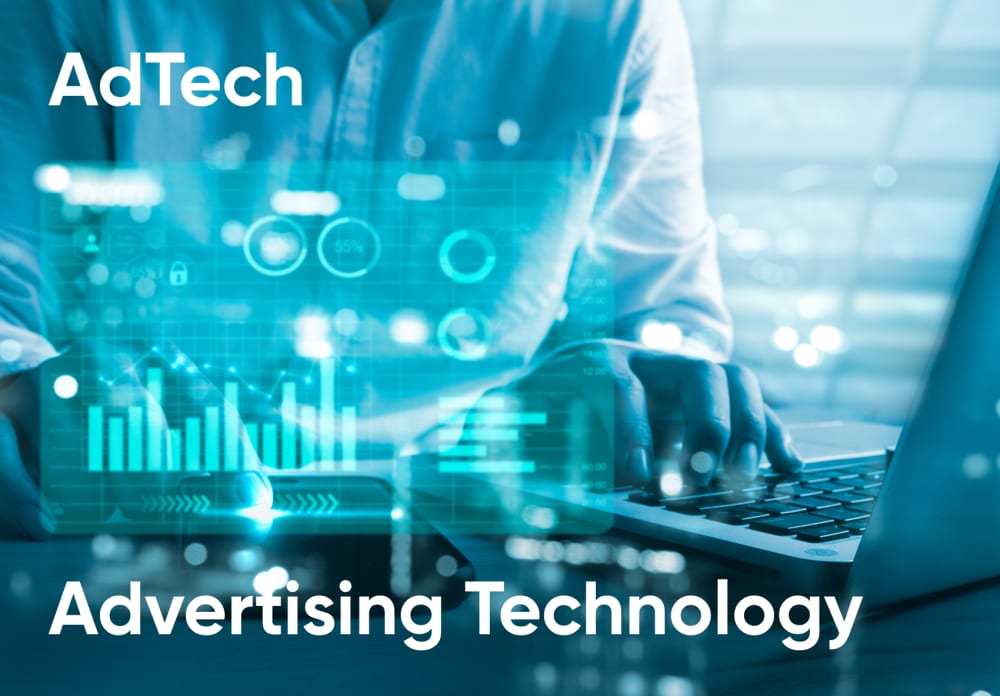

A look at Examples, Trends, and Dealing With Privacy Issues affecting all industries
Modern emerging technologies contribute to a deep analysis of many types of business, taking them to a new level. Advertising technology, or AdTech, is one of them.
AdTech is now seen as a fundamental aspect of a digital advertising campaign and as a major advantage in a company's digital advertising efforts. It also accounts for a large percentage of the Big Data users according to industry. Advertisers use this revolutionary development as part of their marketing strategy to purchase and measure digital advertising.
The emergence of AdTech was a means of streamlining and simplifying the increasingly complex process of buying and selling ads for digital advertising campaigns. It is not enough already for publishers and advertisers to make appointments, since nowadays businesses interact with their customers differently. Digital advertising evolution has led to absolutely new ways of attracting customers, keeping them, and turning them into loyal ones.
During this article, we will answer questions such as; "What does AdTech mean? How is it possible to benefit from it?" and, "What are the regulations?"
As an experienced software developer, Go Wombat has developed several successful AdTech projects.
What Is Advertising Technology
(Ad Tech)?
AdTech is an advertising technology, and it is a broad term that includes many tools and software platforms for setting up and displaying ads to potential customers throughout advertising campaigns. Using advertising technologies, advertisers collect large amounts of audience data, accurately identify their target audience, set targeting parameters and assess the profitability of campaign investments.
The Ad Tech term combines different analytical digital tools used by specialists in the advertising market to manage advertising campaigns and analyse them.
Based on received information about customers, advertising technologies allow for personalising advertising communication, showing announcements to the concerned audience at the right time when the audience is more perceptible to see this ad.
Why is AdTech Important?
AdTech includes many tools that ad agencies, advertisers, or publishers use for tracking, managing, and monetisation of their ad campaigns. Simply put, AdTech aims to improve customer-business interaction, buy and sell ads, and optimise methods for advertisement distribution.
The analysis of the target audience, ad management and delivery, and ad channels' efficiency growth is linked to the basis of the digital advertising industry. Advertisers and publishers can generate revenue effectively. All industries are looking to this new form of advertising, and for some it is essential. For example websites such as hotels and tour operators would benefit from an advantageous insight. Also, owners of ad platforms can sell display ads and ad space at a profitable price.
Finally, the importance of the Ad Tech companies is their contribution to the simplification of the process of comparison between advertisers' demand and publishers' supply in ad networks.
What are examples of AdTech?
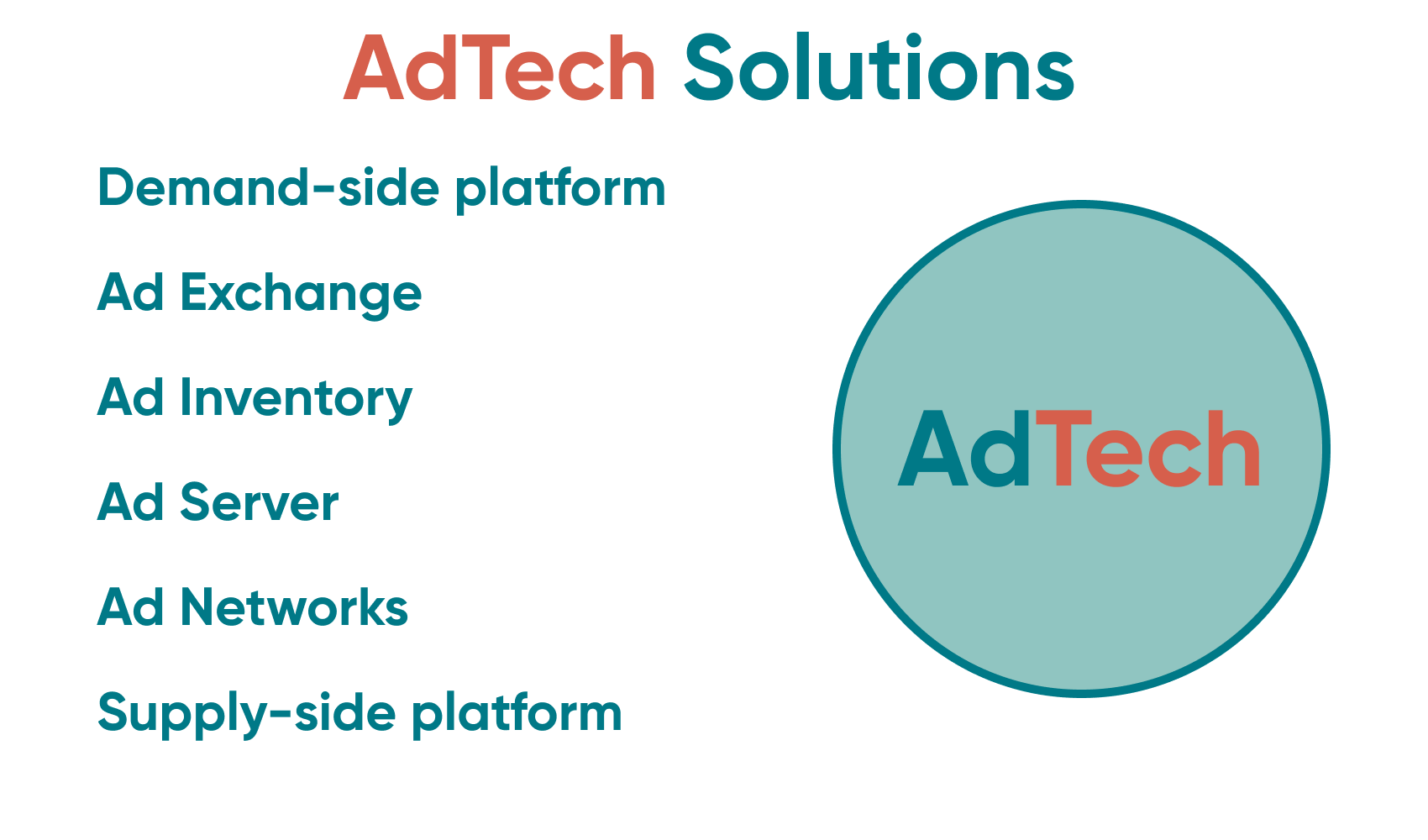
There are different Ad Tech solutions and platforms, but we want to show a few examples of ad tech use cases for your consideration.
Ad Inventory
This is an ad space provided by the publisher to advertisers for ad placement. Depending on the type of advertising sales deal, there can be "Guaranteed inventory," also known as programmatic advertising and "Remnant inventory". Guaranteed inventory refers to ad space that is assigned to a specific advertiser during a direct sale (without intermediaries). Remnant inventory is sold via ad networks on open or closed auctions. Ad networks consolidate the inventory of different publishers and provide it for purchase to advertisers.
Ad Exchange
This is an advertising space exchange that simplifies buying and selling media advertising (video advertising, etc.). So ad exchanges allow you to buy media ads efficiently.
Ad Network
The platform consolidates advertisers and ad websites, and its key purpose is to offer ad space and search for advertisers.
Ad Server
Software that stores ad content intended for placement on publishers' websites and mobile apps.
Demand-side platform
The solution allows buying ad spaces automatically according to the pre-configured settings. This is an alternative to ad networks.
Supply-side platform (SSP)
The technological platform that represents the interests of sellers and sells ad inventory. The purpose of supply-side platforms is to sell ad inventory at the maximum price.
The Benefits of Advertising Technology (AdTech)
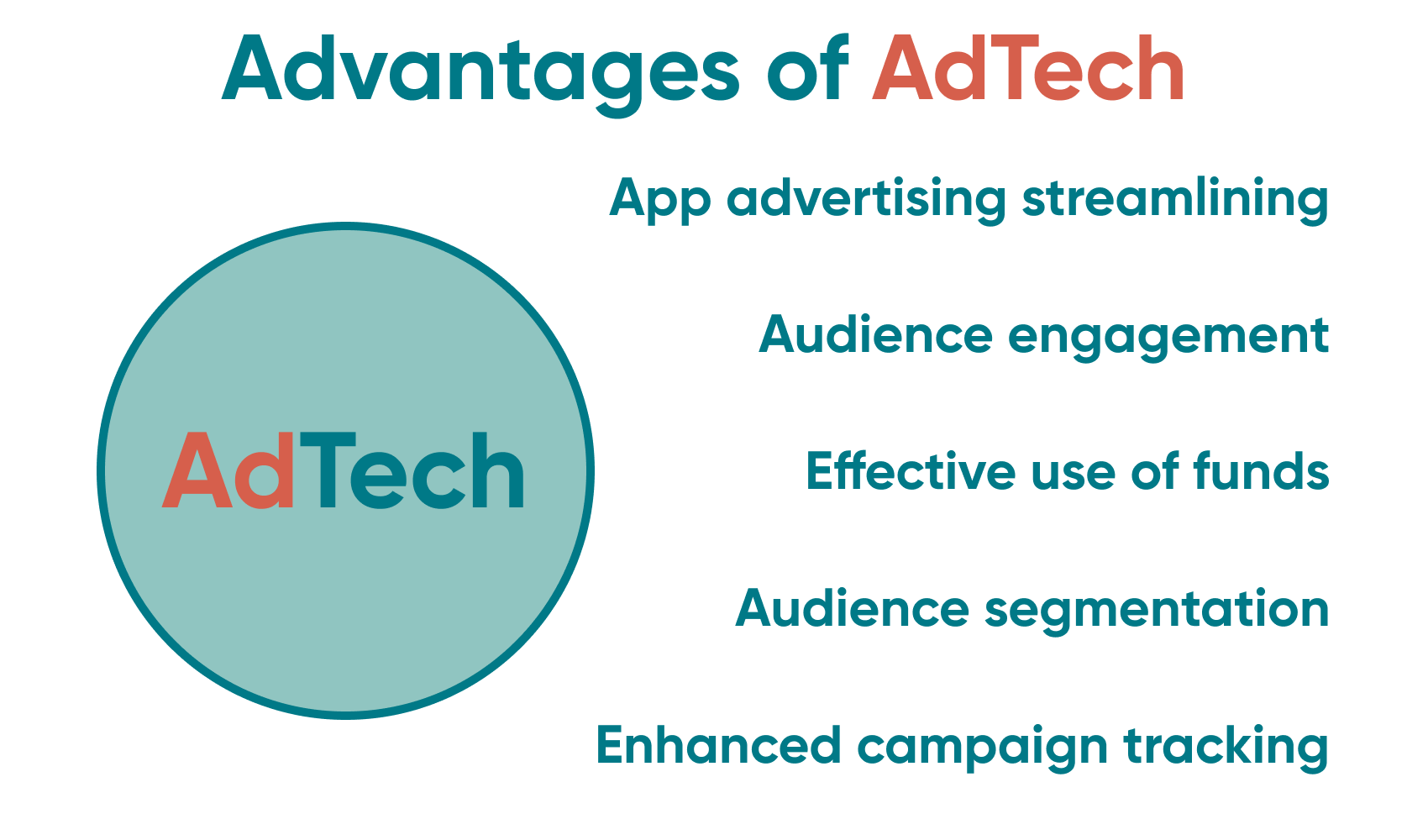
Programmatic Advertising Campaigns have become more efficient thanks to AdTech, helping businesses provide the correct targeting to their customers. For a business, this is a major advancement in digital marketing.
Effective use of funds
Media buyers can generate ad content that meets the expectations of an intended audience. Algorithms of AdTech tools may define what content is widespread and when it is better to show it to customers. Thus, companies invest funds effectively and avoid unnecessary losses so that they can control their budget.
Enhanced campaign tracking
Using ad servers, it is possible to get more comprehensive campaign results, so companies can see what campaign and where it fits better. This contributes to productivity, simplifies media buying, and optimises business processes.
Audience segmentation
As everyone understands, creating one ad that will suit everyone is impossible. Your customers may require different ads depending on the marketing funnel stage. That is why AdTech is a must-have technology to target different audience segments with relevant advertising.
Audience engagement
A relevant ad campaign can attract and keep potential customers, since campaigns may follow the focus of customers. In addition, higher engagement leads to more suitable monetisation techniques and, as a result, higher profits.
App advertising streamlining
Many people use smartphones today, so targeting mobile app users with a decent ad is crucial. Various AdTech tools help you promote your app, and it is possible to provide users with what they want and need.
Build your AdTech product with Go Wombat — contact us!
Advertising Technology Trends
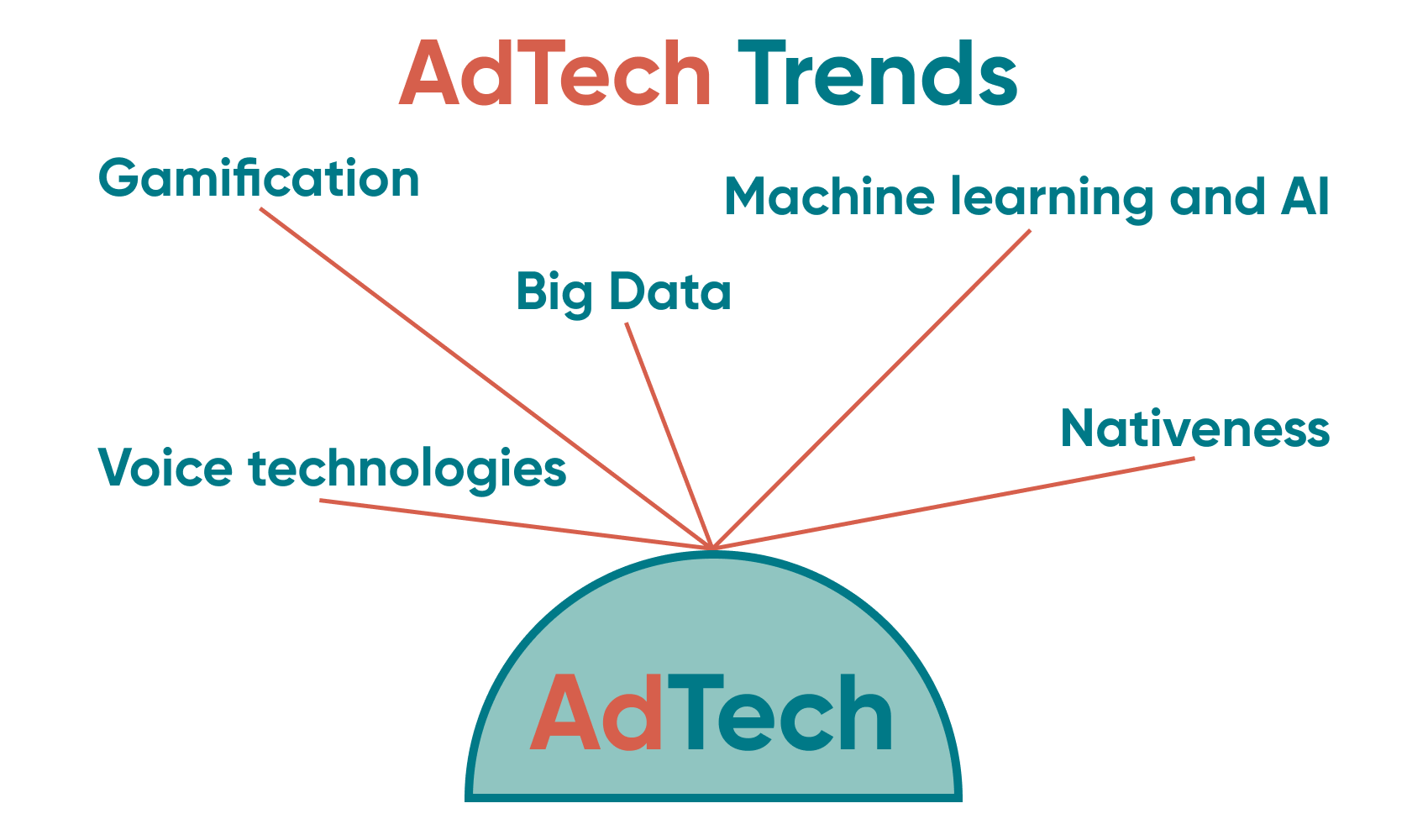
How is it possible to use your advertising technologies for the benefit of your business? As with all industries, there are trends to follow and learn what is or could be important.
Machine learning and AI
This is one of the most popular technologies among advertisers. AI-based algorithms measure and analyse customer data and general consumers that enable them to set up targeting and selection of relevant ad content. The analysis of the content environment is based on computer vision.
Big Data
Analytics are important in all sales funnel stages. Therefore, many advertisers strive to use Big Data algorithms. Go Wombat has vast experience in creating Big Data tools and integrating BD as part of the software development process, so we can always do it for you. Big Data also provides predictive analytics that will help to accurately determine the target audience's preferences.
Gamification
Entertaining content is always popular among users, so gamification also works very well in advertising. VR and AR technologies are incorporated in ads, so users can perceive them better, and gamification positively affects customer loyalty.
Voice technologies
Today, more users prefer digital content, and many of them listen to podcasts. Relevant platforms try to benefit from it and provide interactive opportunities for advertisers (apart from standard solutions like playlists, video clips, etc.). For example, Google is already actively testing dynamic advertising. Advertisers are looking for ways to adapt voice SEO optimisation of websites. According to TechTarget, voice SEO is the optimisation of keywords and keyword phrases for searches using voice assistants. According to some SEO experts, voice SEO is required for websites to show up in results for searches conducted through voice assistants. Google also states that approximately 20% of all searches occur through voice.
Native and Contextual based
Users don't want to be distracted from interesting content when an advertisement is popping up on the screen. Therefore, ad tech platforms allow advertisers to integrate ads natively into their corporate videos.
Privacy Protection Issue In AdTech: How To Deal With It
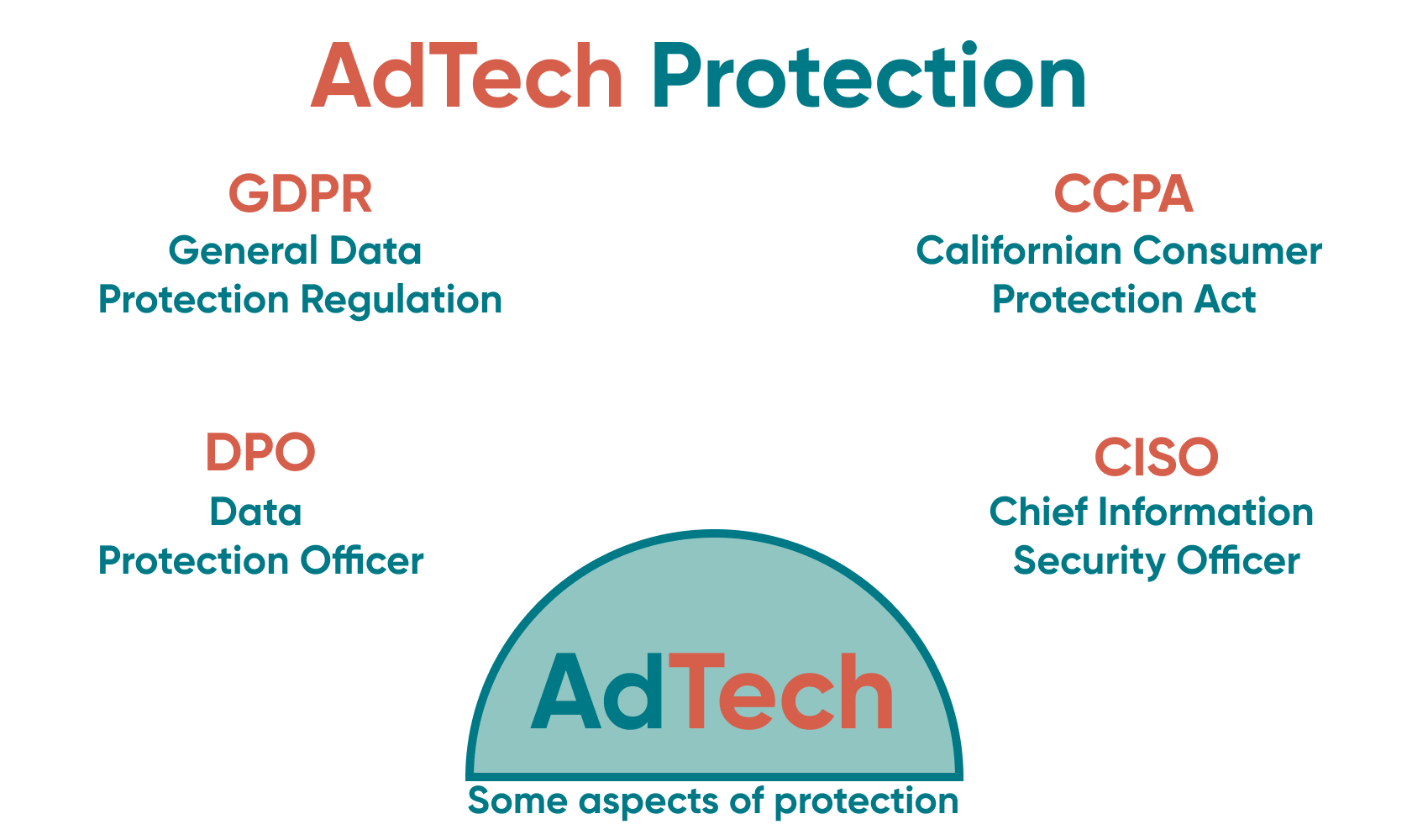
Website and app owners can monetise their products and reach their target audience, and users can get access to these products for free.
However, it is worth considering that AdTech solutions have become more invasive over the past years. For example, target advertising requires large amounts of data about people to capture their attention and motivate them to become customers.
As a result, advertisers track all our online activities, preferences, and visits to build a profile and understand our expectations better. However, it is getting more complicated to figure out how all our personal data can be used and where data ends up.
The Severity Of The Problem
The problem is that AdTech solutions can be very intrusive, and sometimes they may even be discriminatory (for example, a woman cannot see some job offers because she is a woman, or someone cannot rent an apartment since his or her neighbourhood is considered inappropriate).
Users have no control over the ways in which their data is used as no one can guarantee that their personal information is not sold and shared with a third party).
It leads to data privacy issues, breaches of privacy, higher security risks, and a lack of trust from users towards specific websites or applications. For example, when a social media app discloses private information and makes it public, it can even be dangerous for people.
A Solution Has Come
Therefore, new regulative standards are on a governmental level. Governments created such regulations as GDPR, HIPAA, and CCPA to protect personal information and oblige service providers to work, with personal data carefully, following all legal aspects.
To discover more on this topic, read GDPR and HIPAA certification. This is an informative article on the process and technical compliance of GDPR at Go Wombat. In addition, we have a Chief Information Security Officer, and a certified Data Protection Officer to ensure the compliance of software we create with GDPR.
Start working with Go Wombat to make your AdTech project secure and reliable — contact us!
A Compliance Monitoring Tool
As we noted, companies working with customers’ data must comply with existing regulations. If they violate rules, they will need to pay penalties. To ensure respect for the customers’ rights, service providers are looking for software development companies like Go Wombat. We can help develop tools for monitoring and full compliance.
About The Project
One of the GDPR rules states that users should give consent to personal data processing. All websites that process information of every user who visits a website must receive consent from users. If users decline to use their data, websites cannot use it. Previously, web services haven’t adhered to any rules.
Go Wombat recently embarked on another AdTech project for a source-point company. This project involves a scanner that checks a website's compliance with GDPR when collecting personal data.
The specialised AdTech tool verifies whether there is correct consent and that a website doesn’t violate the GDPR rules. This product collects and tracks all traffic that comes out of a website. Also, it explores how vendors work with a website and what cookie files it stores.
It is crucial that only when a user accepts the processing of personal information, that any advertising can be displayed.
Functionality
The product allows customers to see details about the behaviour of each vendor on a page, and see valuable recommendations on how to fix each issue. Vendors are advertisers who publish their ads and pay for this.
It helps customers use the information about requirements compliance by vendors, and customers can prioritise vendors by their privacy risks, review changes, and apply updates to your content marketing platform.
The product enables tracking of compliance journey. It is possible to see compliance progress over time compared with specific benchmarks. Also, using selected compliance metrics, it is possible to track vulnerabilities.
Challenges
One of the essential things for our project was to develop it correctly from the startup stage to a full-fledged product. Therefore, we spent a lot of time working on software architecture. Also, we worked on iterative up-building of product functionality — we have been redeveloping parts of the functionality in specific stages.
We have built a skilled team that has appropriate expertise levels. In addition, we created cloud-native microservices, which helped us change parts of a product without affecting the functionality of other product parts.
Tech Stack
As mentioned above, we have created our own cloud-native microservices to use with AWS services. As usual, Python was our primary back-end development language, while the React library and Vue.js framework were used for front-end development.
We utilised the Docker container as a tool for creating containers and launching apps in these containers. It helps create an isolated environment with the required OS.
Also, for stable and quick functionality, we used serverless platforms AWS Lambda and Fargate.
We used Selenium — an open-source library created for automated web application testing.
Finally, to ensure confidentiality and increase security, we used proxy servers.
Result
The "Source-point" company now has a ready-made product to provide its customers. As with many of our projects, we continue to maintain and service the product, working with the company’s management team for successful cooperation.
Unlock Success with Premium Software Development
Contact us


Why Should You Work With Go Wombat?
At Go Wombat, we provide full-stack development, including all services to create your software from initial ideas — business analysis, consultancy, quality insurance, and maintenance. Our primary goal is to ensure that your product is bug-free and provides relevant services to the target audience.
The Go Wombat company has been building web and mobile applications for over six years. Being specialised in many industries, we cover healthcare, travel and hospitality, logistics, oil and gas, marketing and advertising. We strive to improve our services and build trustful relationships with our clients since their satisfaction means our success.
Let’s proceed to your project development — hire Go Wombat!
How can we help you ?






